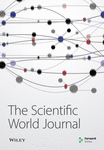Approach to Multiple Pulmonary Nodules: A Case Report and Review of Literature
Abstract
Chest X-ray and CT examinations often find pulmonary nodules that could be malignant or benign. A case is presented and discussed here in order to improve diagnosis and management of pulmonary nodules. A 62-year-old lady was found to have multiple pulmonary nodules by X-ray when she complained of a cough and fever. This was confirmed by a CT scan. Fine needle aspiration (FNA) of one of the lung lesions reported scant atypical epithelial cells that stained positive for TTF-1 and cytokeratin 7, but negative for cytokeratin 20. Thus, it was suspicious for large cell carcinoma. A videothoracoscopic lung biopsy and histopathology were applied and showed a necrotic nodule with surrounding chronic inflammation and macrophage response, with no evidence of malignant cells. Atypical reactive pneumocytes at the periphery of the lesion (an old infarct) were probably equivalent to the atypical cells seen on cytology. This result changed the diagnosis of our patient from a malignant condition to a benign process. Thus, CT and FNA may give a false positive. A second pathological opinion is very useful for the right diagnosis and management, as shown in our case.




